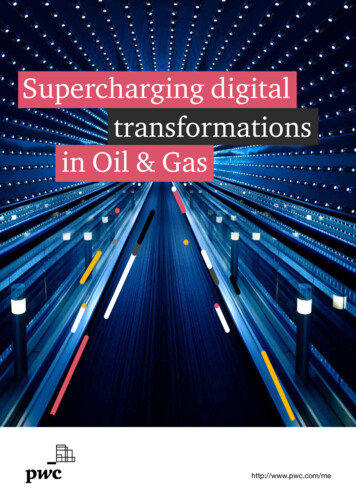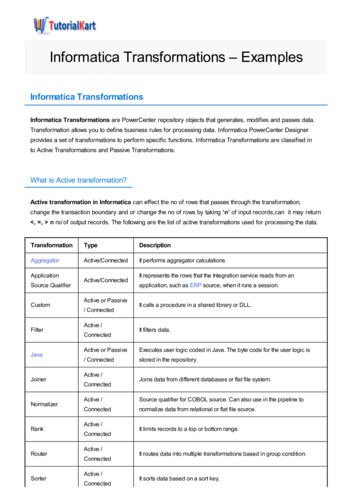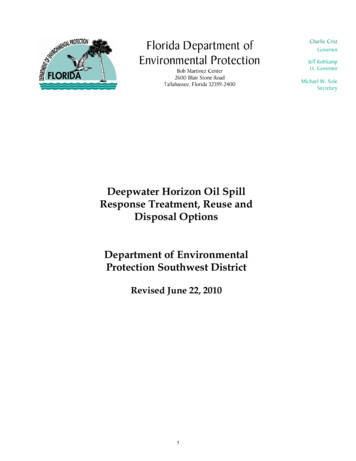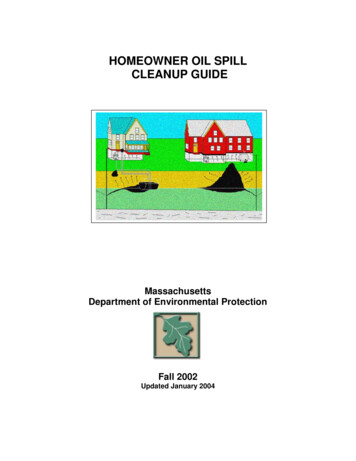
Transcription
Supercharging digitaltransformationsin Oil & Gashttp://www.pwc.com/me1
ExecutiveSummaryAll Oil & Gas operators have now embarked on someform of digitisation, capitalising on the promised gainsof the fourth industrial revolution. Today, the shocksof oil price pressures and COVID-19, combined withgrowing momentum to transition to a low carbonfuture, accelerates the need for Oil & Gas companiesto capitalise on promised gains and ‘supercharge’ theirdigital agendas.2
In this paper, we focus on three common challenges that Oil & Gasoperators are facing in achieving their digital strategies and identify stepsthey can take to address them to ‘supercharge’ results.Data & infrastructureData quality is a major concern for decision makers. It is often poorlyintegrated, scattered across multiple systems, unstandardised and sounwieldy it is difficult to extract any value from it.Key considerations: Master data management, governance and security Optimised digital architectures Clearly defined cloud strategy Standardisation and configuration when adopting software as aservice (SaaS)Business case realisationOrganisations often struggle to determine ‘true’ return on investment andbuild a strong, data-driven business case to secure stakeholder buy-in.Key considerations: Design a holistic and coordinated digital programme Take a business-led (not technology-led) approach to requirementscapture Establish strategic partnerships with win-win scenarios Reduce development cycle time with ‘turbo-innovation’People, organisation & cultureMany digital strategies underestimate the availability of talent in theright areas and requirements to drive end user adoption, as well as fitfor-purpose business models to truly enable digitalisation.Key considerations: Embrace ‘agile’ Focus on behavioural change Consider a layered approach to upskilling Integrate and blend data scientists within business units andengineering teams3
Introduction
Digitalisation is not new, however COVID-19 hassharpened the focus and accelerated momentumBy its very nature, the Oil & Gas sector has been atthe forefront of the technological curve at many pointsin time. So much so that NASA has been workingclosely with Oil & Gas technologists to leverage theirintellectual property in support of man’s mission toMars and beyond.1 Paradoxically, however, the sectorhas lagged behind other industries when it comesto shifting towards ‘Industry 4.0’ and although themajority of Oil & Gas operators have now embarked onsome form of digitisation, capitalising on the promisedgains of the fourth industrial revolution, has alludedmany and the pressure is mounting.Once again, the industry finds itself in a bind. Thedual shock of the oil price collapse and COVID-19 hasforced operators to shed costs, increase efficienciesand drive shareholder value, all whilst keeping theiremployees and the public safe. Combine this witha growing momentum to transition to a low carbonagenda, reliant on new technologies to offer smarteroptimised solutions and transparent reporting.As a result, Oil & Gas companies need to capitalise onpromised gains and ‘supercharge’ their digital agendas.“Aerospace Oil & Gas: Technologies for New Horizons,” NASA, accessed March 2, 2021, wnloads/20140004423.pdf103
Key challengesand steps to take
With increased pressure on return on investment (RoI) realisation,Oil & Gas operators are experiencing common challenges indigital strategy implementationWhile many challenges are operator-specific and even field or facility-specific, others are being experienced by Oil& Gas operators across the industry and its value chain. Common challenges include:Data & infrastructureGiven increasing volumes and security risks, data quality, data management and actionable datainsights are an ever-increasing concern for decision makers. Data often remains scattered acrossdisparate systems and is not commonly or consistently structured, integrated or developed with a‘cloud strategy’ in mind.Business case realisationDetermining ‘true’ return on investment and building a strong, data-driven business case to securestakeholder buy-in can be challenging. Momentum is often lost as organisations struggle to defineand track use cases, and demonstrate tangible value, under aggressive timelines. Additionally,collaboration across business units can be challenging when levels of digital maturity and digitalinfrastructure vary.People, organisation & cultureInstilling behaviours, ways of working, methodologies and approaches that embrace digitaltechnologies and solutions within the organisation can also be challenging and result in low useracceptance. Many digital strategies underestimate the availability of talent in the right areas andrequirements to drive end user adoption.Within each challenge area, operators should consider thefollowing core elements and what strategies they can employ to‘supercharge’ digital transformationChallengesData & infrastructureBusiness caserealisationPeople, organisation& cultureConsiderations in addressing challenges Enhance master datamanagement, governance andsecurity Design a holistic andcoordinated digital programme Take a business-led (nottechnology-led) approach torequirements capture Continuously map and optimisedigital architecture Clearly define your cloudstrategy Establish strategic partnershipswith win-win scenarios Opt for standardisation& configuration of SaaSapplications Reduce development cycle timewith ‘turbo-innovation’ Adopt ‘agile’ Focus on behavioural change Consider a layered approach toupskilling Integrate and blend datascientists within business unitsand engineering teamsAll organisations are at different starting points and stages along their digitisation journey; understanding wherethey stand and what progression challenges they are facing is imperative to moving forward.05
Data & infrastructureEnhance master data management, governance and securityData can only be valuable if it is processed andaccessible. Ensuring master data management andgovernance fundamentals are in place will ensuresecure and organised data of sufficient quality isavailable to all employees and machines in real-time.In order to build robust data management, all datasources must be understood and organised in terms oftheir purpose, criticality and connectivity.As an illustration of effective datamanagement and governance,Exxonmobil targets to achieve 95%time savings due to their dataquality centres.2Data governance should focus on continuouslyevaluating and enhancing data assets, so usershave the confidence that it is fit for purpose anddecision-makers can steer the right course, groundedin a single version of the truth. Setting clear datagovernance principles and applying them consistentlyallows for more effective data mining. Without them,interoperability will remain a theoretical construct.Finally, strong data management and governanceare futile without adequate security. Cyber threatson industrial systems are becoming more targeted,and as a result, more potent and complex. Oil & Gasorganisations are advised to implement strict securitymeasures to secure all their networks, endpointsand controllers. While top-tier cloud providers do anexcellent job of securing services, it is the client’sresponsibility to secure applications and data. Aligningthe cloud security environment with the organisation’soverall security strategy is key.Continuously map and optimise digital architectureDigital architecture is defined as the layout andintegration of sensors, applications, databases,systems and networks across a company’s operations.Visualising and analysing digital architecture helpsidentify optimisation and integration opportunities.Therefore, digital architecture should be continuouslyupdated to maintain an accurate global view of acompany’s digital assets and their integration.Oil & Gas operators should have an approach in placefor IT infrastructure to ‘keep up’ with the business’sdigital ambitions, for example: to manage big dataassets, to support planned digital applications andnew ways of working. In some cases legacy systemswill need to be replaced entirely, and in other cases,new systems and solutions can sit on top of existinghardware.“ExxonMobil Data Quality Center achieves 95% time savings,” Tableau, accessed March 2, 2021, bil-data-quality-center-time-savings-huge206
Clearly define your cloud strategyToday, most Oil & Gas organisations do not havea formal cloud strategy, which sets out a coherentapproach to cloud usage – optimising resources andcosts, while ensuring continuous access to real-timedata for oilfield intelligence. A cloud strategy is anoutline for the role of cloud in an organisation, not aplan to move everything to the cloud.Digital leaders, such as chief information officers(CIOs), chief data officers (CDOs) and chief technologyofficers (CTOs), develop and update a cloud strategy toensure cloud decisions align with corporate goals andaccount for all necessary factors and potential risks,and the C-suite buy-in. Some companies have evencreated a ‘Cloud Council’ composed of stakeholdersfrom across the business, which demonstrates itsimportance beyond the core digital teams.A clearly defined cloud strategy is also critical forpreparing for and supporting artificial intelligence andmachine learning solutions. A comprehensive cloudstrategy includes a business baseline, service strategy,financial models, workload assessments, securityassessments and requisite elements. For national oilcompanies specifically, cloud strategy has warrantedrenewed focus given the massive attainable benefitsthat can be achieved when deployed at scale acrosstheir organisations. This has had to be balanced withrestrictions around data sovereignty and nationalregulation.BP has seen significant savingsin annual licensing, support andmaintenance costs (over 50,000savings in hardware costs) by runningthe lubricants ECC system on AWSCloud, and will now progress theentire SAP landscape to the cloud inthe next 18 months.3Opt for standardisation & configuration of software as a service(SaaS) applicationsStandardisation in an enterprise digital environmentallows faster scaling and time-to-value. Traditionalsolutions require a tremendous amount ofcustomisation and a large amount of custom code.With enterprise SaaS solutions we observe a pushtowards standardisation and configuration as opposedto customisation. The more configuration is built in: thefaster the time-to-delivery, the easier it is for customersto adopt and the more integration there is with existingprocesses. High standardisation and configuration alsoallows for easier version migration. When it comes toSaaS, less is often more.3“BP Case Study, Amazon Web Services (AWS),” accessed March 20, 2021, 7
Business case realisationDesign a holistic and coordinated digital programmeTo reap the benefits of scale, a holistic approachto digital strategy across an organisation usuallyyields better results. Although, in some instances,a specific line of business may require a tailoredapproach and infrastructure. Digital strategy andtransformation maximise benefits to the organisationwhen implemented across teams and functions, not inisolated pockets. While use cases clearly vary acrossthe organisation, core technology enablers such ascloud and application development tools can bestandardised and integrable.Shell has worked with Microsoft toleverage products such as AzureBoards and Azure Pipelines toensure their digital transformationteam is well equipped to fast-tracktheir digital journey, by reducingtheir development cycle frommonths to weeks.4Take a ‘business-led’ (not technology-led) approach torequirements captureTypically, technology-led approaches result in loweruser adoption and behavioral change, since end-usersdo not see a clear link between deployed solutionsand their day-to-day requirements, challenges andopportunities.Digital strategy implementation should be led by thebusiness and its core business units, particularly thosethat impact bottom-line spend most heavily and/orcan directly contribute to production and efficiencyincreases. Moreover, core business units are becomingmore digitally fluent, utilising an array of systems andtools that allow them to better shape requirementsfor digital solutions being implemented by technologyproviders or in-house digital teams.OMV conducted an in-depthbusiness-wide analysis to identifythe areas of its business wheredigital transformation wouldhave the greatest impact. Thisthen guided investment and thedefinition of high-impact digitalinitiatives followed, all driven bybusiness unit requirements. Notably,OMV considers ‘digital ways ofworking’ as a key pillar in their digitaltransformation journey.5“Shell gives developers freedom to create, reduces IT costs with dev-test solution in the cloud,” Microsoft, August 21, 2018, mining-oil-gas-azure5“Innovation, Technology & Digitalization,” OMV, accessed March 2, 2021, ationtechnology-digitalization408
Establish strategic partnerships with win-win scenarios“This foundational element cannot be stressed enoughin terms of its criticality. Given the rate at which thedigital ecosystem is expanding – to now includelarge corporations, small-to-medium sized vendors,integrators, startups, think-tanks, research bodies anduniversities – the organisations that will win at digitalstrategy implementation are those that intelligentlybuild partnerships that complement their offering ratherthan those who attempt to build all capabilities andsolutions in-house. These partnerships often yield winwin situations through the design and roll-out of highRoI solutions, where both parties have a vested interestin sustainable implementation performance rather thanjust an up-front deal. An appropriate balance should bestruck between the protection of proprietary technologyand the development of high-performing solutions.C3.AI CEO Thomas M. Siebel:“This initiative is about combiningthe efforts of global leaders toaccelerate the digital transformationof the energy industry to new, safe,and secure energy and to ensureclimate security.”6Shell have recently launched Shell.ai, an ‘Open AI Energy Initiative’ (OAI) in partnership with BakerHughes, Microsoft, and C3.ai – afirst-of-its-kind open ecosystemof artificial intelligence (AI)-basedsolutions for the energy and processindustries. The OAI provides aframework for energy operators,service providers, equipmentproviders and independent softwarevendors for energy services to offerinteroperable solutions, includingAI and physics-based models,monitoring, diagnostics, prescriptiveactions and services.6Reduce development cycle time with ‘turbo-innovation’7‘Turbo-innovation’ is an approach to reduce theinnovation cycle time in building digital platformsand solutions. This is done through strict scope,data source management and leveraging ‘prefabricated’ front- and back-ends, resulting inincreased success rates, reduced time-to-value andoverall de-risking of initiatives. ‘Turbo-innovation’utilises a framework that aims to realise tangiblesolutions and value over six weeks. Early phasesare completed in a cross-functional setting, withrapid innovation cycles that allow frequent coursecorrections based on insights gained.“Shell, C3 AI, Baker Hughes, and Microsoft Launch the Open AI Energy Initiative, an Ecosystem of AI Solutions to Help Transform the EnergyIndustry,” Baker Hughes, 1 February 2021, rosoft-launch-open-ai-energy096
Typically the framework aims to realise tangible solutions and value over six weeksAlignment and scopingFront-loading(1-2 weeks)Week 1Understanding issuesand ensure manageableweek 1 scopeStrategic alignmentand prioritise problemportfolioExecution, implementationand testingWeek 27Identify and prioritisepotential solutions,including data validationWeek 3-4Develop front-end/UI,test and iterateWeek 5-6Develop back-end, test,iterate, finalise MVPWeek 7-8Implement, test andinitiate rolloutContinuousprioritisationof scope anddeliverablesStakeholdermanagementPwC Norway10
People, organisation & cultureAdopting agile cultureThe pursuit of real and rapid innovation through digitalwill inevitably result in some failures – an agile culturecan support the celebration of failing and the ability tofail fast. Organisations with an agile culture can adoptinnovative solutions to internal and external challengesmore easily and build their flexibility to alter directionmid-stream if conditions change. Enabling, and in fact,encouraging teams to fail fast fosters innovation and isa cornerstone to an agile culture.Total has established ‘BoosterSpaces’ in the heart of their keylocations, accessible to all, as theyfocus on innovation, incubation, andhackathon spaces.8Achieve behavioural changeWhen it comes to digital strategy implementation, thedissemination of information and the communicationcampaign are not sufficient for ensuring results.Rather than just knowing a digital strategy exists in theorganisation, people need to feel that they are a partof it and understand how it will benefit their team – thispaves the way towards behavioural changes and themodernisation of traditional day-to-day tasks.Taking one end of the extreme, tech companies likeGoogle have transformed their entire workforce intoan innovation churning machine that rapidly producesnew products, tests them, fails, succeeds andimplements every single day. These behaviours havebeen embedded into the culture at Google throughmany years of identifying ideal behaviours and drivingcampaigns to cement them. Oil & Gas operators shouldreflect on these practices and look to adopt a similarapproach.Executives responsible for digitalenablement at Baker Hughes havespent 25% of their time workingwith corporate communicationsto limit the confusion around theterm ‘digital’ and to talk about thepotential opportunities.9“Total launches a “plant 4.0” corporate incubator,” Total, December 18, 2015, tallaunches-plant-40-corporate-incubator9Strategy& Katzenbach Centre811
Consider a layered approach to upskillingInvestment in capability-building should occur acrossthe organisation, particularly in core business areas,driving up the overall digital acumen in order toaccelerate adoption. A layered approach to upskillingcan be taken, whereby everyone receives, at aminimum, basic digital awareness and skills. Digitalenthusiasts are then enabled to pursue their interestby enrolling in further training and digital acceleratorsin order to drive change within their teams. Focusshould be applied to developing a pipeline of futuredigital leaders and innovators. Starting with graduatepositions focused on digitalisation and the applicationof an innovative mindset, organisations shouldincreasingly see digital as a core competency for futureleaders.Equinor established a digitalacademy and its employees haveclocked a total of 150,000 digitallearning sessions since 2018,approximately 7 sessions peremployee.10Integrate and blend data scientists within business units andengineering teamsData science is a key aspect of the skill-set neededto design and implement digital solutions. With thatin mind, data science should be seen as a capabilitypillar in organisations with true digital ambitions.Furthermore, data scientists themselves should notbe seen as an extension of IT teams. Data scientistsshould be blended into business units, geological &geophysical specialist teams and engineering teams,working collaboratively from an early stage of challengeor opportunity capture, all the way through to testingand roll-out.Strangely enough, blending will likely reveal newopportunities for performance improvement throughdigital that were not initially obvious to business units.Given that the systems used by operations staff andtechnicians are now increasingly digital, blending ofdata scientists allows teams to better leverage valuablenew operating data being churned out.A key subject to address in this area has been theavailability of data science talent, specifically focusedon the Oil & Gas industry – a scarcity which hasbeen brought about by both a crew change and aninclination for younger graduates to gravitate towardsindustries perceived as ‘cleaner’. Data scientists thatspecialise in Oil & Gas applications are not plentiful innumber, nor evenly distributed across global Oil & Gashotspots.1011Data scientists should be embeddedpermanently into teams wherethey can be used continuously.For instance, Shell has a networkof around 800 data scientistsdeployed across the businessto help scale their transformationjourney.11PwC AcademyShell Investor Day, 11 February 202112
Final thoughtsWhile Oil & Gas companies look to bounce back postCOVID-19, gearing towards the new normal, it is timeto accelerate the implementation of digital strategiesin order to reap the benefits promised by ‘Industry4.0’. Having a strong digital strategy is nothing withoutrobust implementation. A weak strategy executedperfectly is better than a strong strategy that has failedto implement – one is digital progress and the other is areport gathering dust.To find out more about how we can help your business,please visit us at www.pwc.com/me or get in touch.Neil O’KeeffeRabih NassarAhmad AbuHantashEnergy, Utilities & ResourcesIndustry LeaderPwC Middle Eastneil.okeeffe@pwc.comPartner, Oil & GasPwC Middle Eastrabih.nassar@pwc.comEnergy, Utilities & ResourcesTechnology LeaderPwC Middle Eastahmad.abuhantash@pwc.comMatthew WhiteEdward WillingElias GhantousDigital Trust LeaderPwC Middle Eastmatthew.white@pwc.comDirector, Oil & GasPwC Middle Eastedward.willing@pwc.comSenior Manager, Oil & GasPwC Middle Eastelias.ghantous@pwc.com13
http://www.pwc.com/meAt PwC, our purpose is to build trust in society and solve important problems. We’re a network of firms in 155 countries withover 284,000 people who are committed to delivering quality in assurance, advisory and tax services. Find out more and tell uswhat matters to you by visiting us at www.pwc.com.Established in the Middle East for 40 years, PwC has 22 offices across 12 countries in the region with around 6,000 people.(www.pwc.com/me).PwC refers to the PwC network and/or one or more of its member firms, each of which is a separate legal entity. Please seewww.pwc.com/structure for further details. 2021 PwC. All rights reservedCDC 0285 042021
Exxonmobil targets to achieve 95% time savings due to their data quality centres.2 Enhance master data management, governance and security Continuously map and optimise digital architecture Digital architecture is defined as the layout and integration of sensors, applications, databases, systems and networks across a company's operations.










